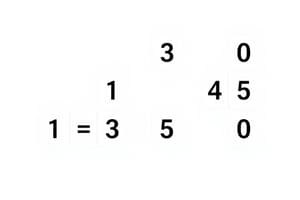Podcast
Questions and Answers
What is a key feature of radix sort regarding the digit sorting process?
What is a key feature of radix sort regarding the digit sorting process?
- It sorts starting from the most significant digit.
- It requires extra storage for each digit.
- It sorts on the least significant digit first. (correct)
- It uses a comparison-based sorting algorithm.
In the context of radix sort, what is the role of the stable sort used in each pass?
In the context of radix sort, what is the role of the stable sort used in each pass?
- To increase overall sorting time.
- To maintain the input order among equal elements. (correct)
- To sort in multiple passes over the same digit.
- To create random distributions of the elements.
What is the time complexity of radix sort when both d and k are manageable?
What is the time complexity of radix sort when both d and k are manageable?
- O(n log n)
- Θ(d(n+k)) (correct)
- O(n^2)
- Θ(n^3)
What is a limitation of radix sort with respect to memory usage?
What is a limitation of radix sort with respect to memory usage?
What is the purpose of dividing the range [0, 1) into buckets in bucket sort?
What is the purpose of dividing the range [0, 1) into buckets in bucket sort?
What condition is assumed about the input for bucket sort to function effectively?
What condition is assumed about the input for bucket sort to function effectively?
When analyzing the performance of bucket sort, what primarily affects the efficiency of sorting within each bucket?
When analyzing the performance of bucket sort, what primarily affects the efficiency of sorting within each bucket?
Which of the following statements regarding counting sort is accurate?
Which of the following statements regarding counting sort is accurate?
What is the average-case time complexity of quick sort when applied to random arrays?
What is the average-case time complexity of quick sort when applied to random arrays?
In which scenario does quick sort exhibit worst-case time complexity?
In which scenario does quick sort exhibit worst-case time complexity?
What is the best-case time complexity for the quick sort algorithm?
What is the best-case time complexity for the quick sort algorithm?
Which statement about randomized algorithms in quick sort is true?
Which statement about randomized algorithms in quick sort is true?
What is the role of the RANDOMIZED-PARTITION function in the quick sort algorithm?
What is the role of the RANDOMIZED-PARTITION function in the quick sort algorithm?
What time complexity does quick sort achieve with a 9-to-1 proportional split?
What time complexity does quick sort achieve with a 9-to-1 proportional split?
When quick sort runs as fast as merge sort, what is this scenario referred to?
When quick sort runs as fast as merge sort, what is this scenario referred to?
Which sorting algorithm does counting sort depend on an assumption regarding input values?
Which sorting algorithm does counting sort depend on an assumption regarding input values?
What is the initial step in the Quick Sort algorithm?
What is the initial step in the Quick Sort algorithm?
In the Quick Sort algorithm, what is meant by 'partitioning'?
In the Quick Sort algorithm, what is meant by 'partitioning'?
Which of the following describes the best case time complexity of Quick Sort?
Which of the following describes the best case time complexity of Quick Sort?
What happens in the worst case scenario for Quick Sort?
What happens in the worst case scenario for Quick Sort?
What is the purpose of the variable 'i' in the PARTITION function of Quick Sort?
What is the purpose of the variable 'i' in the PARTITION function of Quick Sort?
In Quick Sort, when do you perform the exchange operation A[i] ↔ A[j]?
In Quick Sort, when do you perform the exchange operation A[i] ↔ A[j]?
How does Quick Sort combine the sorted parts of the array?
How does Quick Sort combine the sorted parts of the array?
During which step is the pivot value chosen in Quick Sort?
During which step is the pivot value chosen in Quick Sort?
What is the correct order of operations in the Quick Sort algorithm?
What is the correct order of operations in the Quick Sort algorithm?
What will happen if the same pivot is consistently chosen in Quick Sort?
What will happen if the same pivot is consistently chosen in Quick Sort?
In the Quick Sort algorithm, what will the final result be after all partitions and sorts?
In the Quick Sort algorithm, what will the final result be after all partitions and sorts?
What is typically used as the pivot in the Quick Sort algorithm?
What is typically used as the pivot in the Quick Sort algorithm?
What does the term 'glue pieces together' refer to in Quick Sort?
What does the term 'glue pieces together' refer to in Quick Sort?
What type of algorithm is Quick Sort classified as?
What type of algorithm is Quick Sort classified as?
Flashcards
Counting Sort
Counting Sort
A sorting algorithm that utilizes a counting mechanism to determine the frequency of each element in a sorted array. This algorithm assumes that the input elements are integers within a known range.
Radix Sort
Radix Sort
A sorting algorithm that sorts elements based on their individual digits, starting with the least significant digit and progressing to the most significant digit. It requires a stable sorting method for each digit pass.
Bucket Sort
Bucket Sort
A sorting algorithm where elements are distributed into buckets based on their range. Each bucket is then sorted individually, and finally, the elements from all buckets are combined in sorted order.
Linear Time Sorting
Linear Time Sorting
Signup and view all the flashcards
Stable Sorting
Stable Sorting
Signup and view all the flashcards
In Place Sorting
In Place Sorting
Signup and view all the flashcards
Worst Case Time Complexity
Worst Case Time Complexity
Signup and view all the flashcards
Loop Bound
Loop Bound
Signup and view all the flashcards
Quick Sort Average Case
Quick Sort Average Case
Signup and view all the flashcards
Quick Sort Worst Case
Quick Sort Worst Case
Signup and view all the flashcards
Worst Case Partitioning for Quick Sort
Worst Case Partitioning for Quick Sort
Signup and view all the flashcards
Best Case Partitioning for Quick Sort
Best Case Partitioning for Quick Sort
Signup and view all the flashcards
Quick Sort Runtime Between Best and Worst
Quick Sort Runtime Between Best and Worst
Signup and view all the flashcards
Randomized Algorithms for Quick Sort
Randomized Algorithms for Quick Sort
Signup and view all the flashcards
Randomized Partition
Randomized Partition
Signup and view all the flashcards
Randomized Quick Sort
Randomized Quick Sort
Signup and view all the flashcards
Quick Sort
Quick Sort
Signup and view all the flashcards
Partitioning
Partitioning
Signup and view all the flashcards
Pivot
Pivot
Signup and view all the flashcards
Left Subarray
Left Subarray
Signup and view all the flashcards
Right Subarray
Right Subarray
Signup and view all the flashcards
Conquering
Conquering
Signup and view all the flashcards
Combining (in Quicksort)
Combining (in Quicksort)
Signup and view all the flashcards
Best Case (Quick Sort)
Best Case (Quick Sort)
Signup and view all the flashcards
Worst Case (Quick Sort)
Worst Case (Quick Sort)
Signup and view all the flashcards
Bubble Sort
Bubble Sort
Signup and view all the flashcards
Pigeonhole Sort
Pigeonhole Sort
Signup and view all the flashcards
Time Complexity
Time Complexity
Signup and view all the flashcards
Space Complexity
Space Complexity
Signup and view all the flashcards
Study Notes
Quick Sort
- Quick sort is a divide-and-conquer sorting algorithm
- It partitions the input array around a pivot
- Elements smaller than the pivot are placed before the pivot, and elements larger are placed after
- Subarrays are recursively sorted until the entire array is sorted
- Pivot selection can be crucial for performance
Quick Sort: Partition
- The pivot is selected randomly or using a specific strategy
- Elements are compared to the pivot
- Elements smaller than the pivot are moved to the left part of the array
- Elements larger than the pivot are moved to the right part
- The pivot is placed at its correct position
Quick Sort: Combining
- Base case is met when p >= r
- The subarrays are recursively sorted independently using Quick sort
- The subproblems are trivially combined because of partition operation
Quick Sort: Time Complexity
- Best Case: O(n log n), when the partition always divides the array into roughly equal halves
- Average Case: O(n log n), typically achieved with randomized pivot selection
- Worst Case: O(n2) if the pivot is always the smallest or largest element (e.g. a sorted array)
Linear Time Sorting (Counting Sort)
- Counting sort works with integers within a specific range.
- It counts the occurrences of each input element.
- It builds a cumulative frequency array, then places elements in the output array based on these counts.
Time Complexity of Counting Sort
-
Best, average, worst-case execution time: O(n) (linear)
-
Additional auxiliary storage: O(k), where k is the range (maximum key) of the input elements
Radix Sort
- Sorts numbers by iterating over their digits, starting with the least significant digit.
- Requires using a stable sorting algorithm for each digit pass.
Radix Sort Time Complexity
- Best, average, and worst case: O(nk), where n is the number of elements, k is the number of digits (or the length of the largest key). If k is fixed and not dependent on n, the time complexity is linear.
Bucket Sort
- Bucket sort assumes input values are uniformly distributed in a given range.
- The input range is divided into equal-sized buckets
- Elements are distributed into their respective buckets.
- Each bucket is sorted individually (e.g., using insertion sort).
- The elements of the buckets are combined to get the sorted output.
Time Complexity of Bucket Sort
- Best, average, worst case: O(n), provides linear running time if the input is evenly distributed
Randomized Algorithms
- These algorithms' correctness does not depend on the input sequence
- It does not eliminate the worst-case scenario but makes it less probable
Studying That Suits You
Use AI to generate personalized quizzes and flashcards to suit your learning preferences.





